Abstract
The Xianghai National Nature Reserve of Jilin is located on the East Asian-Australian migration route of birds and plays an important role for migratory waterbirds. To explore the influence of restoration measures on migratory waterbird communities in Xianghai Reserve, we conducted a waterbird survey in the spring and autumn during waterbird migration from 2010 to 2020. The composition and spatial and temporal changes in waterbird communities were identified in the reserve and the diversity changes in waterbird communities were analyzed. The results showed that (1) the number of waterbirds increased significantly since restoration measures in 2012. Restoration measures has clearly promoted an improvement in the species and number of waterbirds. The number of waterbirds was approximately seven-times higher than that before restoration measures. (2) The number of rare waterbirds increased in the reserve, and the number of Anseriform waterbirds on the IUCN Red List of Threatened Species rapidly increased. (3) The diversity of the waterbird community has shown some recovery in the reserve, but the variation in water level during some periods led to a regular fluctuation in waterbird diversity. Restoration measures directly changed the water surface area and the water depth in the reserve, which are important variables that influence waterbird selection of wetlands as habitats. To effectively protect and manage important stopover sites on the migratory routes of waterbirds, we suggest to rationally regulate the supplementary water level of wetlands, optimize the hydrological pattern of wetlands, and strengthen the regulation of wetland water levels.
1. Introduction
Waterbirds are flocking species that depend on wetlands for survival, and they are the most active component of wetland ecosystems [1]. Their community composition and diversity directly reflect changes in wetland ecosystems and monitor changes in the wetland environment as an objective biological indicator. [2]. Waterbirds have clear seasonal migration patterns. A series of available wetland stopover sites along the migration route are the basis for ensuring the success of waterbird migration [3,4]. These stopover sites are an important source of energy resupply for waterbirds during migration and provide food and habitat for different populations.
The Xianghai National Nature Reserve of Jilin is located in west of the Songnen Plain on the migration route of East Asian-Australian migratory birds. It is a breeding place for rare species such as Grus japonensis and Ciconia boyciana and a migration stopover site for endangered waterbirds such as Grus leucogeranus. At the beginning of this century, as a result of climate change and anthropogenic factors, wetland habitats were extensively lost in this region. This loss seriously affected the breeding and migration of waterbirds [5]. To better protect waterbirds and wetlands, since 2012, the River-Lake Linkage Project has been carried out to restore the hydrological conditions of lakes and marshes. However, there has been no study on the influence of ten years of restoration on the number and diversity of waterbirds in different wetland habitats. Therefore, the aim of this study was to analyze the effectiveness of the restoration measures for the conservation of waterbird species. We analyzed waterbird data for a total of 11 years before and after the restoration measures from 2010 to 2020. We explored the dynamic characteristics of waterbird diversity in the lake reservoir and marsh habitats in response to the restoration measures, which provide a basis for the conservation of migratory birds in the East Asia-Australia flyway and the scientific management of migratory stopover sites.
2. Materials and Methods
2.1. Study Area
The Xianghai Reserve is located in Tongyu of Jilin Province (Figure 1) (122°5′~122°31′ E, 44°55′~45°09′ N) and has a total area of 1050 km2. This reserve was included in the first group of sites on the List of Wetlands of International Importance in China in 1992. The reserve is an important stopover site for migratory waterbirds and a breeding place for summer migratory birds in the Asia-Pacific region. The main objects of protection include birds (e.g., Grus japonensis and Ciconia boyciana) and their habitats [6]. The reserve is situated in a semiarid area with the continental monsoon climate of the northern temperate zone. Most rainfall occurs in summer. The average annual precipitation is approximately 370 mm, and the average annual evaporation is approximately 1890 mm [7].
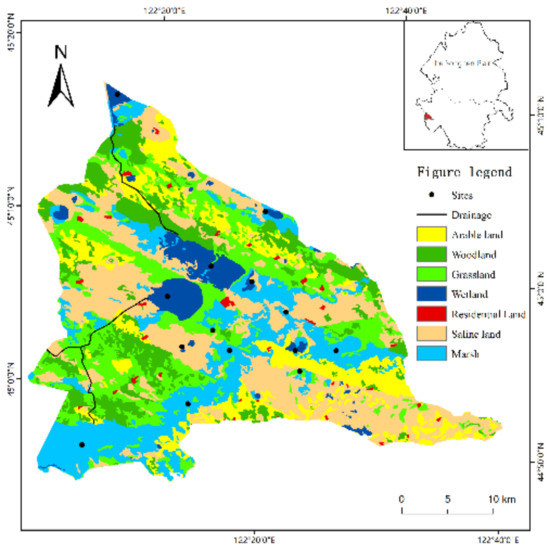
Figure 1.
Location of the study area and sample points.
Before the restoration measures, due to the unreasonable exploitation of wetland resources, grassland resources, and water resources, a series of ecological and environmental problems had arisen in the reserve, mainly manifested in the decrease of grassland area, shrinkage of wetland area, increase of sandy and saline land area, etc. The restoration measures were carried out in this region in 2012. The lakes, reservoirs, and seasonal and dry marshes that were originally isolated were reconnected by the restoration measures in the Xianghai Reserve. The lakes and reservoirs in the region are supplied with water by the Tao’er River and the Huolin River and water to the surrounding marsh wetlands is supplied through their connected waterways. After the restoration measures, the area of water bodies and wetlands in the reserve increased, providing suitable habitat for the waterbird community in the Xianghai Reserve. At the beginning of the restoration measures, the annual water diversion in the region was approximately 4.00 × 107 m3 from 2012 to 2014. The water diversion reduced to 1/3 of the initial diversion from 2015 to 2016. At the end of the restoration measures, water diversion is consistent with the level at the beginning of the restoration measures.
2.2. Bird Survey Methods
A total of 14 observation sites set up based on the historical stopover sites of waterbirds in the study area (Figure 1), including five reservoir habitats and nine marsh habitats [8]. The survey objects only include waterbirds that traditionally roost in or near water and did not include Falconiformes, Accipitriformes, or Passeriformes that depend on wetlands for survival. We classified the waterbirds in the area into four types based on their habitat preferences: dabbling birds, diving birds, large waders, and small waders. The dabbling birds mainly include Anatidae, Laridae, and Rallidae. The diving birds include Anseriformes, Gavia, Podicipediformes, and Phalacrocoracidae. The large waders mainly include Ciconiiformes and Gruiformes. The small waders mainly include most of the Charadriiformes and Scolopacidae.
Based on the migration pattern of waterbirds in the study area, waterbirds were observed from March to May and September to November each year from 2010 to 2020. The waterbird migration periods in spring and autumn were divided into three stages: premigration, mid-migration, and post-migration. There were two observations in each stage with an interval of 3~4 days. Binoculars (8 × 32x) and monoculars (20 × 60x) were used to scan the sample area clockwise during the survey to record the species and number of waterbirds. Direct counts were used for species with small numbers of individuals, and species with large numbers of individuals or flocks were counted by units of 10, 20, or 50 birds [9]. Species classification and identification were based on the List of the Classification and Distribution of Birds in China (3rd edition), edited by Zheng Guangmei [10]. The endangerment level of waterbird species in the study area was determined according to the Red List of the International Union for Conservation of Nature (IUCN).
2.3. Habitat Landscape in Remote Sensing Interpretation
Landsat 5 and Landsat 8 images with a path-row number of 120–029, which were captured on 2 July 2010, 8 July 2015, and 11 June 2020, were selected to interpret the marsh wetlands and water body for the area of the Xianghai Reserve. OLI images that were generated during the summer (from June to August) of each year were also selected to assist with interpretation, as multi-temporal features can help distinguish objects. The object-oriented segmentation method based on eCognition 9.3 was combined with a random forest model to extract land cover information. Water level and water diversion data of the study area were obtained from Xianghai Reservoir.
2.4. Data Analysis
Using a regression model, we examined the correlations between different physical features of the wetlands such as water body area, and water level, and the waterbird abundance, waterbird species richness, and diversity indices. We used the Shannon–Wiener diversity index and the G-F index to analyze the diversity of waterbird communities in the region [11].
Shannon’s Diversity Index was calculated using the equation:
where pi is the proportion of proportion of bird number of species i in the total bird abundance.
We used the Berger–Parker dominance index to judge the population size classes, which can be calculated as follows [12].
where Ni is the number of individuals of species i and N is the total number of all species in the community. When I ≥ 0.1, species i is a dominant species, 0.01 ≤ I ≤ 0.1 indicates that species i is a common species, and I < 0.01 indicates that species i is an occasional species.
3. Results
3.1. Waterbird Species and Numbers
3.1.1. Species and Population Changes in Regional Waterbirds
We recorded a total of 110 waterbird species from 2010 to 2020 in the study area, belonging to 10 orders, 17 families, and 50 genera.The main taxon was Charadriiformes (40 species), accounting for 36.36% of waterbird species in the study area. Anseriformes, Pelecaniformes, and Gruiformes had 36, 12, and 9 species, respectively, accounting for 32.72%, 10.91%, and 8.18% of the waterbird species in the study area. The proportions of the other six orders were all less than 5%. Among the recorded waterbirds, the dominant species were Anser fabalis and Aythya ferina. There were 17 common species (Anser albifrons, Anas platyrhynchos, Grus leucogeranus, Grus monachal, etc.), most of which belonged to the family Anatidae. The other species were occasional.
We analyzed the annual dynamics of the waterbird community in the Xianghai Reserve from 2010 to 2020 based on the number of species and individuals for 10 orders (Figure 2). The results showed that the number of waterbird species decreased in the study area from 2010 to 2012, increased from 2013, reached a maximum number of species in 2018, and then showed a decreasing trend. The number of waterbird individuals showed the same decreasing trend as the number of species from 2010 to 2012, increased annually from 2013 to 2016, decreased annually from 2016 to 2019, and suddenly reached a maximum in 2020. The change of regional water diversions influenced waterbird abundance and water body area in the reserve. At the beginning of the restoration measures, the water body area reached a maximum number, and then showed a decreasing trend year by year. We investigated the differences in water diversion on waterbird abundance and water body area through employing regression mode, which has a positive correlation with interannual water diversion. When the water diversion maintained at 5.00 × 107 m3, the waterbird abundance was at a stable level.
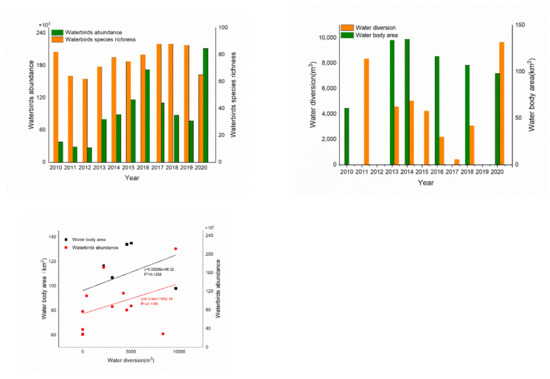
Figure 2.
Annual dynamics of waterbird species and numbers in Xianghai Nature Reserve.
3.1.2. Changes in Waterbird Species and Numbers in Different Habitats
Anatidae waterbirds occupied the main part of the lake and marsh habitats in the Xianghai Reserve. The dominant species Anser fabalis and Aythya ferina were distributed in the marsh habitat (Table S1). The common species Anas poecilorhyncha, Mergellus albellus, and Platalea leucorodia were distributed in both habitats. Gruiformes waterbirds such as Grus leucogeranus, Grus grus, and Fulica atra were mainly distributed in the marsh habitat and less in the lake reservoir habitat.
The number of waterbird species in marsh habitats was consistently higher than that in the lake reservoir habitats from 2010 to 2020 in the Xianghai Reserve (Figure 3). Since 2012, restoration measures have been carried out in the study area. At the beginning of the restoration measures, the area of marsh habitat increased significantly. In the middle of the restoration measures, the area of marsh habitat showed a decreasing trend (Figure 4). With the increase in the marsh habitats, the proportion of waterbird species in marsh habitats continued to increase from 2010 to 2013 and reached a maximum (63%) in 2013. The proportion of species in marsh habitats decreased from 2016 to 2017 and from 2019 to 2020, which has a similar trend in marsh habitats change.
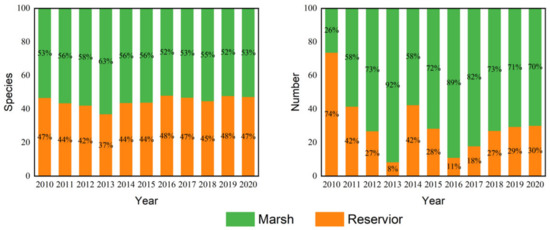
Figure 3.
Proportion of species and number of waterbirds in different habitats in Xianghai Nature Reserve.
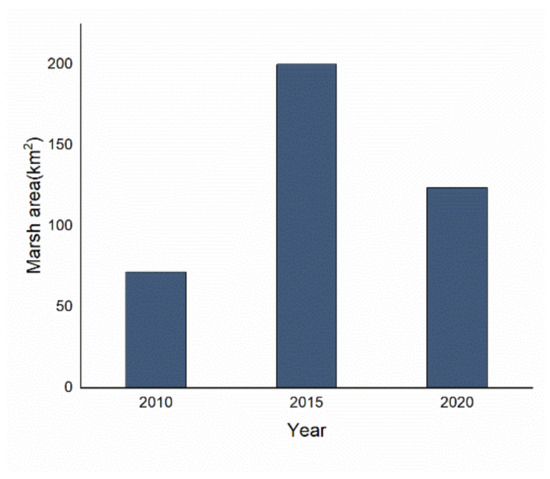
Figure 4.
Changes in the area of marsh in the Xianghai Nature Resreve.
The number of waterbirds in the reservoir habitat was higher than that in the marsh habitat in 2010 (Figure 3). The proportion of waterbirds in the marsh habitat continued to increase from 2011 to 2013 and reached a maximum (92%) in 2013. The proportion of waterbirds in the marsh habitat fluctuated in other years, but overall, it was higher than that in the reservoir habitat.
3.2. Rare Waterbirds
Changes in Rare Waterbird Species and Numbers in the Region
Among the 110 species of waterbirds that are distributed in the Xianghai Reserve, 17 species are on the IUCN Red List of Threatened Species, accounting for 15.4% of the total waterbirds that are distributed in the reserve, which is much higher than the overall level of threatened waterbird species in China (10.6%) [13]. There are two species of critically endangered (CR) waterbirds (Grus leucogeranus and Aythya baeri), two species of endangered (EN) waterbirds (Ciconia boyciana and Tringa guttifer), eight species of vulnerable (VU) waterbirds (including Grus japonensis and Grus vipio), and six species of near threatened (NT) waterbirds (including Aythya nyroca and Numenius arquata).
We investigated the contact between the IUCN Red List of Threatened Species and time through employing regression models (Figure 5). The proportion of dependent variable (Y) impacts on independent variables (X) was explained by linear regression, which indicated the number of protected birds increased year by year after the restoration measures in 2012. In the Xianghai Nature Reserve, only the endangered waterbirds showed a decreasing trend. Critically endangered waterbirds, vulnerable waterbirds, and near threatened waterbirds showed the same trend, with their numbers increasing year by year. The number of vulnerable waterbirds changed more dramatically than the other two categories.
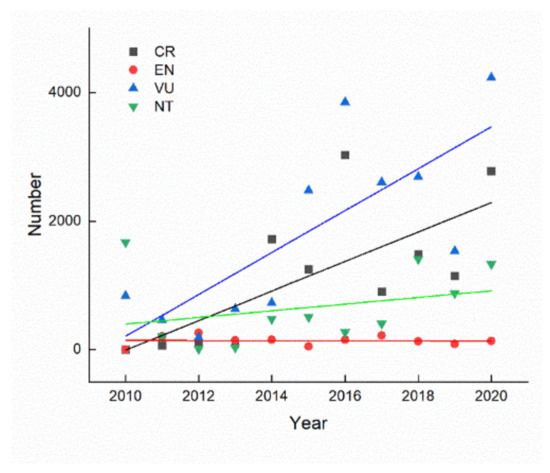
Figure 5.
Bird numbers in relation to their IUCN red list status. Note: CR denotes critically endangered waterbirds; EN denotes endangered waterbirds; VU denotes vulnerable waterbirds; NT denotes near threatened waterbirds.
3.3. Waterbird Diversity
3.3.1. Changes in Waterbird Diversity in Different Habitats
The Shannon–Wiener diversity of waterbirds in the reservoir and marsh habitats of the Xianghai Reserve from 2010 to 2020 showed more dramatic interannual variation (Figure 6). The marsh showed a trend of regular fluctuation with the lowest (and similar) values in 2012, 2016, and 2020 (2.01 ± 0.07) and the highest values in 2010, 2014, and 2018 (2.60~2.84). The Shannon–Wiener diversity of the reservoir had a larger fluctuation with the highest value (3.12) in 2016 and the lowest value (1.83) in 2020. The change trend of the Shannon diversity index in the study area was similar to that of marsh habitat. After the restoration measures in 2012, there was an overall rising trend. The trend of reservoir habitats was opposite, showing a negative correlation.
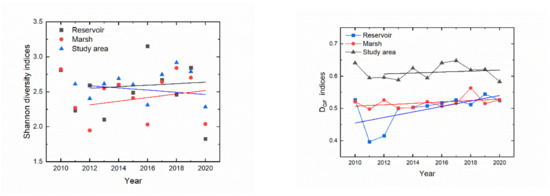
Figure 6.
Annual variation of species diversity index of waterbirds in different habitats. Note: Study area denotes all data in the marsh and reservoir together.
The interannual variations of in the reservoir and marsh habitats of the Xianghai Reserve from 2010 to 2020 are shown in Figure 6. In the marsh habitat, the indices of showed overall increasing trends and reached their maximum values in 2018 ( = 0.56). In the reservoir habitat, the indices of decreased from 2010 to 2012, showed an increasing trend from 2013, and reached their maximum value in 2019 ( = 0.54). In the study area, the index of was generally stable and maintained at 0.58~0.65 in all years. After the restoration measures in 2012, the overall trend was rising.
3.3.2. Changes in Diversity for Different Types of Waterbirds
The correlations of waterbird abundance, waterbird species richness, and Shannon-Wiener indices of different types of waterbirds to water level fluctuations were analyzed during 2010–2020 (Figure 7). Waterbird abundance showed a positive correlation with the water level, and the wetland replenishment in the reserve promoted the increase of waterbird populations. Waterbird species richness is negatively correlated with the water level, and when the water level is too high it has a negative effect on waterbird species richness in the reserve. Waterbird abundance and species richness in the study area were maintained at relatively high levels when the water level was maintained at about 2 m.
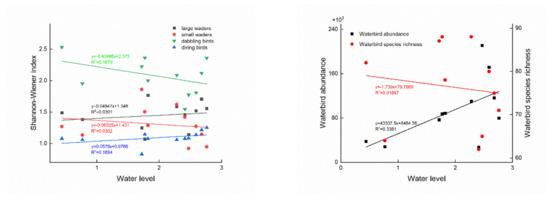
Figure 7.
Effects of water level changes on waterbird abundance, waterbird species richness, and four waterbird guilds.
Dabbling birds and small waders showed a negative correlation with water level fluctuations, and the water level increasing would lead to a decreasing trend in waterbird diversity in these two waterbird guilds. Diving birds and large waders showed a positive correlation with water level fluctuations, and the water level increasing was conducive to promote the recovery of these two waterbird guilds. At the water level of about 1.5 m, the Shannon–Wiener diversity of four waterbird guilds was relatively high, and the water level at this time was conducive to the recovery of the waterbird population diversity.
4. Discussion
4.1. Waterbird Species and Numbers
The Xianghai Reserve is an important stopover site for migratory birds from East Asia-Australia during their north–south migration, and a large number of migrating waterbirds make a brief stopover here every spring and autumn. The dynamic changes in waterbird species and numbers directly reflect the utilization and quality of habitat. Water level change in wetlands is a key factor influencing waterbird foraging and habitat selection [14,15,16]. The species diversity of migratory waterbirds also changes with fluctuations in wetland water level [17]. A series of restoration measures have been carried out in the Xianghai Reserve since 2012. The water surface area increased and migrated to the north, and the water level and vegetation composition have changed [18,19]. The number of waterbird species decreased by 17 species before the implementation of restoration measures, and the number of waterbirds continued to decline from 2010 to 2013. After restoration measures in 2012, the number of species increased and remained stable, and the number of waterbirds significantly increased. In the marsh habitat, the waterbird community trends were the same as the overall trends in the study area, with significant recovery in waterbird abundance and species richness after the restoration measures. The number of waterbirds in 2016 was approximately seven times higher than that in 2012. The restoration measures significantly contributed to the enhancement of waterbird species and numbers.
The water level change significantly affected the number of waterbirds. The highest proportion of waterbirds was found in shallow water habitats [20]. The waterbirds in the Xianghai Reserve are mainly composed of Anseriformes, Gruiformes, and Charadriiformes, whose main habitats are shallow mudflats and grass flats [21]. These taxa are concentrated in the marsh habitats. During restoration measures, the change in water diversion can directly affected the water level of the marsh habitat. Changes in waterbird abundance and species richness in the study area mostly responded to fluctuating changes in water levels (Figure 7). If the water level is too high or too low, the number and species of waterbirds in the marsh habitat will be affected. When the water diversion decreased, and the hydrological conditions changed from 2017 to 2020. The number of dominant and common species such as Anseriformes and Charadriiformes greatly fluctuated and showed a downwards trend. The increase in water diversion caused the waterbird population to reach its peak since the restoration measures in 2020. The changes in the number of waterbird species concentrated in the fluctuation of Charadriiformes from 2017 to 2020, which are more sensitive to changes in water level and microhabitat than Anseriformes [22]. When the regional hydrological situation changed, the species and number of waterbirds also greatly changed.
4.2. Changes in Numbers of Rare Species
Waterbirds on the IUCN Red List of Threatened Species such as Grus japonensis, Grus leucogeranus, Cygnus cygnus, and Anser erythropus select plant tubers as their main food source in the Xianghai Reserve [23]. Birds require an appropriate water depth to meet their habitat needs [24]. Water depth is an important characteristic that affects the habitat of tuber-eating birds. The hydrological situation has fluctuated since the restoration measures that were carried out in Xianghai Reserve in 2012 (Figure 2). The increasing water level contributed to both waterbird abundance and large wader’s diversity (Figure 7). The regional wetlands and vegetation composition have changed [25]. Changes in regional water levels will affect the composition of regional vegetation, which influence the availability of food sources for waterbirds. The traditional food source of Grus leucogeranus, the Bolboschoenus planicalmis, grows only in shallow water, and when the water depth is too high, the vegetation such as Phragmites australis and Typha orientalis, which are suitable for growing in deeper water, increases. This will lead to a decrease in the amount of food resources for Grus leucogeranus [26]. The increase in shallow marsh habitats (Figure 4) in the region has provided more food resources for tuber-feeding birds, resulting in an increase in the number of protected birds in the Gruiformes, Anseriformes, Charadriiformes, and Pelecaniformes. As Anseriform species have a wider ecological niche, their numbers rapidly increased.
Different groups of waterbirds have different habitat needs and make different habitat choices. Wild geese mainly inhabit grassy areas [27]. Ducks prefer open water and shallow marshes [28]. Charadriiformes have their main activity in mudflats. Compared with the waterbirds of Anseriformes, Charadriiformes, and Pelecaniformes, large wading waterbirds (e.g., Grus japonensis and Ciconia boyciana) prefer natural habitats without human disturbance and require larger wetland patches as habitats. Xianghai Reserve is a composite wetland and consists of natural wetlands (marshes) and artificial wetlands (reservoirs and canals). The area of marsh habitat in the region has increased, and the connectivity among wetland patches has been enhanced since the restoration measures in 2012 [29]. Waterbirds of national protection grade preferred shallow marshes and grassland habitats, and taxa such as Anseriformes, Charadriiformes, and Gruiformes have migrated from reservoir habitats to marshy habitats. The large wading birds (i.e., Grus japonensis and Ciconia boyciana) chose marsh habitats with less human disturbance as their habitats. Therefore, the interannual proportion of marsh habitats used was slightly higher than that of reservoirs.
4.3. Changes in Waterbird Diversity
Water level, water area, vegetation composition, and wetland size are important variables affecting waterbird habitat selection. The fluctuation of the water level in the Poyang Lake area that is affected by the Three Gorges Project directly influences the composition of vegetation in the area. The high water has a negative impact on the growth of aquatic vegetation and the number and diversity of wintering waterbird populations [30]. The interannual water diversions in the area have directly changed the water level of the wetland since the restoration measures. The high water will have a negative impact on the diversity of waterbird populations in the region. Therefore, the overall waterbird population diversity has recovered after the restoration of wetlands. However, the high water during some periods has caused regular fluctuations in waterbird diversity.
Large-scale water replenishment was carried out through a water diversion project for marsh habitats in the region from 2013 to 2015, resulting in changes in wetland area, patch connectivity, and water level [31]. The area of marsh wetlands in the central region of the reserve increased, and the stability of wetland patches increased from 2013 to 2015. With the improvement of wetland area, patch connectivity, and water levels, it had a positive effect on the conservation of waterbird communities in the study area. Waterbird abundance, waterbird species richness, and diversity all showed a significant increasing trend (Figure 2 and Figure 6). Compared with unrestored wetlands, restored wetlands typically have higher waterbird abundance, waterbird species richness, and diversity [32]. At the beginning of restoration measures, the marsh habitat quality was restored, and waterbird diversity showed an increasing trend from 2013 to 2014. In the middle of restoration measures, the water level in the region increased from 2015 to 2016 due to a high level of water diversion. When the water level is higher, the area of the water–land transition zone is smaller [31]. The reduced waterbird habitat can lead to a decrease in diversity in the marsh habitat. Water replenishment to the marsh habitat stopped from 2016 to 2018, the water level of the wetlands began to decrease, and the Shannon diversity increased year by year. Compared with artificial wetlands, natural wetlands have higher waterbird diversity. Artificial wetlands can also be used as alternative habitats for waterbird populations [32]. Therefore, the reservoir habitat was an alternative to the marsh habitat before water replenishment in the study area. The diversity of waterbird species was relatively high. The waterbird populations shifted from the original reservoir habitat to the marsh habitat after the restoration measures. The diversity of the reservoir habitat showed a trend that was opposite to that of the marsh habitat.
When the diversity of biological communities is measured in a region, the G-F index can compensate for the deficiency of the Shannon–Wiener index and reflect the diversity among families and genera. The Shannon–Wiener diversity, in the study area showed an overall increasing trend since 2012, indicating that the restoration measures had a positive effect on the conservation of regional waterbird populations. The Shannon index decreased and the indices of increased in the marsh habitat. This reflects the relatively uniform distribution of waterbird species among families in marsh habitats. Therefore, was relatively high. The decrease in the Shannon–Wiener diversity was due to a single dominant species of waterbird, and the number of single species populations in the region has been high since the restoration measures. The indices of in the reservoir habitat showed an overall increasing trend after the restoration measure in 2013, indicating an overall increase in the diversity among families and genera. The water replenishment of the reservoir habitat by the restoration measures improved its quality and increased the number of waterbird species in that habitat [33].
The main objects of the reserve are birds such as Grus japonensis and Ciconia boyciana and their habitats. The Shannon diversity of large waders has been increasing annually since the restoration measures in 2012. The restoration measures played a positive role in the conservation of target species. The enhanced connectivity and aggregation of wetland patches provided suitable habitats for Ciconiiformes and Gruiformes [34]. However, large waders have declined in some years after restoration measures, which played a negative role in the conservation of target species (Figure 7). Diving birds showed an increasing trend at the same time. Diving birds are mainly dominated by Podicipedidae, which is a typical waterbird with a preference for deep water. Its numbers are positively correlated with water level in some areas, whereas the numbers of other waterbirds are negatively correlated with water level [20]. Therefore, the large number of Podicipedidae indicates a greater area of deep water. This water level is unfavorable for other waterbirds. Different waterbirds have different ecological niches due to differences in morphological characteristics and feeding habits. For example, wading birds are concentrated in areas with water depths of 15–20 cm [35]. The fluctuations in diversity indices of dabbling birds and wading birds reflect the changes in the hydrological situation in the region since the restoration measures. Therefore, based on the changes in the number and diversity of dabbling birds, regional water diversion can be regulated to provide a suitable wetland water level for the main protected species in the reserve and maintain their optimal habitat. The annual water diversion in the region was approximately 5.00 × 107 m3 at the beginning of project construction, from 2013 to 2014. The water diversion was reduced to one third of the initial diversion from 2015 to 2016. When the water diversion was maintained at 4.00 × 107 m3 at the beginning of the restoration measures, the overall water level in the study area was maintained at 1.5–2 m. This water level provided a suitable habitat for waterbird communities in the study area, and waterbird abundance, waterbird species richness, and diversity indices of the four waterbird guilds were all at high levels (Figure 7). Waterbirds in the study area were effectively protected at this time.
5. Conclusions
The Xianghai Reserve is an important stopover site on the East Asia-Australia migratory route. To better protect waterbird populations and wetlands, a series of restoration measures were constructed to restore the habitat quality of stopover sites. The number of waterbird species increased and remained at a relatively stable level in the reserve since the restoration measures. The number of waterbirds increased by approximately seven-fold compared with that before the restoration measures. The number of rare birds on the IUCN Red List of Threatened Species has significantly increased with the most rapid increase in Anseriform waterbirds. The diversity of waterbird populations has been restored. The Shannon–Wiener diversity reached its highest value of 2.84 in 2018. However, it has fluctuated at times. Changes in water diversions from the restoration measures will have an impact on the water body area, marsh habitat area, and water depth in the study area, ultimately leading to the changes in waterbird abundance, species richness, and diversity in the region. When the water diversion was maintained at 5.00 × 107 m3, the increasing area of marsh habitat provided more suitable habitats for waterbird populations. The regulation of water diversion should consider rainfall and the water diversion of the previous year. Continuous and large amounts of water diversion can also affect the quality of waterbird habitat. Therefore, in the restoration measures, water diversion should reasonably regulate wetland replenishment, optimize wetland hydrological patterns, and strengthen wetland water level regulation to maintain suitable habitat quality for waterbirds.
Supplementary Materials
The following supporting information can be downloaded at: https://www.mdpi.com/article/10.3390/d14121016/s1. Table S1: Waterbirds species list in reservior habitats.
Author Contributions
Conceptualization, D.L. and H.J.; methodology, S.Z.; software, G.D. and J.G.; validation, H.J. and L.S.; investigation, J.G. and G.D.; resources, B.L. and L.L.; data curation, D.L.; writing—original draft preparation, D.L.; writing—review and editing, H.J. and Y.C. All authors have read and agreed to the published version of the manuscript.
Funding
This research was funded by the National Natural Science Foundation of China, grant numbers U19A2042 and 32271624; National Key Research and Development Program of China, grant numbers 2022YFF1300900.
Institutional Review Board Statement
Not applicable.
Informed Consent Statement
Not applicable.
Data Availability Statement
The data that are presented in this study are available on request from the corresponding author.
Conflicts of Interest
The authors declare no conflict of interest. The funders had no role in the design of the study; in the collection, analyses, or interpretation of data; in the writing of the manuscript, or in the decision to publish the results.
References
- Ma, Z.J. Managing Wetland Habitats for Waterbirds: An International Perspective. Wetlands 2010, 30, 15–27. [Google Scholar] [CrossRef]
- Gregory, R.D.; van Strien, A. Wild Bird Indicators: Using Composite Population Trends of Birds as Measures of Environmental Health. Ornithol. Sci. 2010, 9, 3–22. [Google Scholar] [CrossRef]
- Birgita, D.H.; Peter, M.; Paul, M.; Richard, H.L. Long-term declines in multiple waterbird species in a tidal embayment, south-east Australia. Austral. Ecol. 2015, 40, 515–527. [Google Scholar]
- Mu, T.; Cai, S.X.; Peng, H.B.; Hassell, C.J.; Boyle, A.; Zhang, Z.W.; Piersma, T.; Wilcove, D.S. Evaluating staging habitat quality to advance the conservation of a declining migratory shorebird, Red Knot Calidris canutus. J. Appl. Ecol. 2022, 59, 2084–2093. [Google Scholar] [CrossRef]
- He, C.G.; Ishikawa, T.; Sheng, L.X.; Irie, M. Study on the hydrological conditions for the conservation of the nesting habitat of the Red-crowned Crane in Xianghai Wetlands, China. Hydrol. Process. 2009, 23, 612–622. [Google Scholar] [CrossRef]
- Zhang, Y.H.; Deng, W.; Zhang, S.W. The spatial structure of the Red-crown crane’s habitat in Xianghai National Nature Resreve based on RS and GIS techniques. Acta Ecol. Sin. 2006, 11, 3725–3731. [Google Scholar]
- Qing, H.; Wang, S.; Cui, H.Y. Analysis on the characteristics of climate change in western Jilin Province in 1951–2019. Anhui Agric. Sci. Bull. 2021, 18, 177–179. [Google Scholar]
- He, C.G.; Sheng, L.X.; Lang, H.Q.; Li, L.S.; Zou, L.F. Migration dynamics of Grus japonensis in recent years spring and conservation of its habitat in Xianghai Nature Reserve. J. Appl. Ecol. 2004, 15, 1523–1526. [Google Scholar]
- Li, D.L.; Chen, S.H.; Guan, L.; Lloyd, H.; Liuc, Y.L.; Lv, J.Z.; Zhang, Z.W. Patterns of waterbird community composition across a natural and restored wetland landscape mosaic, Yellow River Delta, China. Estuar. Coast. Shelf Sci. 2011, 91, 325–332. [Google Scholar] [CrossRef]
- Deng, G.M. A Checklist on the Classification and Distribution of the Birds of China, 3rd ed.; Science Press: Beijing, China, 2017. [Google Scholar]
- Jiang, Z.G.; Ji, L.Q. Avain-mammalian species diversity in nine representative sites in China. Biodivers. Sci. 1999, 7, 220–225. [Google Scholar]
- Zhang, Y.F.; Xu, Q.H.; Gao, S.P.; Li, D.M.; Wu, Y.F. Survey of bird diversity in Luanhekou wetland, Hebei Province. Sichuan J. Zool. 2010, 29, 244–248. [Google Scholar]
- Zhang, Y.Y.; Zhang, Z.W.; Dong, L.; Ding, P.; Ding, C.Q.; Ma, Z.J.; Deng, G.M. Assessment of red list of birds in China. Biodivers. Sci. 2016, 24, 568–579. [Google Scholar] [CrossRef]
- Oriane, W.; Mark, A.; Craig, R.; Rebecca, J. Waterbird Responses to Experimental Drawdown: Implications for the Multispecies Management of Wetland Mosaics. J. Appl. Ecol. 2002, 39, 987–1001. [Google Scholar]
- Sándor, F.; Katalin, H. Effects of water level on waterbird abundance and diversity along the middle section of the Danube River. Hydrobiologia 2012, 697, 15–21. [Google Scholar]
- Chang, Z.; Yu, J.Y.; Guang, M.Z.; Jie, L.; Sheng, L.G.; Lu, H.; Shan, S.H.; Hai, P.W.; Yuan, Z.; Hong, X.A.; et al. Influence of hydrological regime and climatic factor on waterbird abundance in Dongting Lake Wetland, China: Implications for biological conservation. Ecol. Eng. 2016, 90, 473–481. [Google Scholar]
- Zhang, S.Q.; Zhang, P.Y.; Pan, B.H.; Zou, Y.A.; Xie, Y.H.; Zhu, F.; Chen, X.S.; Li, F.; Deng, Z.M.; Zhang, H.; et al. Wetland restoration in the East Dongting Lake effectively increased waterbird diversity by improving habitat quality. Glob. Ecol. Conserv. 2021, 27, 15–35. [Google Scholar] [CrossRef]
- Ma, Y.M.; Guo, C.M.; Wang, Y.; Li, J.P.; Tang, X.L.; Chen, L.W. Remote sensing monitoring on area dynamic change of major water bodies in western jinlin province. Bull. Soil Water Conserv. 2018, 38, 249–255. [Google Scholar]
- Ding, C.; Liu, J.P.; Ma, M.Y.; Ma, C.D.; Liu, Y.B. Plant species diversity of meadow-marsh ecosystem in Xianghai. Wetl. Sci. 2017, 15, 552–555. [Google Scholar]
- Jia, Y.F.; Jiao, S.W.; Zhang, Y.M.; Zhou, Y.; Lei, G.C.; Liu, G.H. Diet Shift and Its Impact on Foraging Behavior of Siberian Crane (Grus Leucogeranus) in Poyang Lake. PLoS ONE 2013, 8, e65843. [Google Scholar] [CrossRef]
- Elafri, A.; Belhamra, M.; Houhamdi, M. Comparing habitat preferences of a set of waterbird species wintering in coastal wetlands of North Africa: Implication for management. Ekológia 2017, 36, 158–171. [Google Scholar] [CrossRef]
- Zhang, P.Y.; Zou, Y.A.; Xie, Y.H.; Zhang, H.; Liu, X.K.; Gao, D.L.; Yi, F.Y. Shifts in distribution of herbivorous geese relative to hydrological variation in East Dongting Lake wetland, China. Sci. Total Environ. 2018, 636, 30–38. [Google Scholar] [CrossRef] [PubMed]
- Chatterjee, A.; Adhikari, S.; Pal, S.; Mukhopadhyay, S.K. Foraging guild structure and niche characteristics of waterbirds wintering in selected sub-Himalayan wetlands of India. Ecol. Indic. 2020, 108, 105693. [Google Scholar] [CrossRef]
- Guan, L.; Lei, J.L.; Zuo, A.J.; Zhang, H.; Lei, G.C.; Wen, L. Optimizing the timing of water level recession for conservation of wintering geese in Dongting Lake, China. Ecol. Eng. 2016, 88, 90–98. [Google Scholar] [CrossRef]
- Chen, L.W.; Zhang, G.X.; Xu, Y.J.; Chen, S.B.; Wu, Y.F.; Gao, Z.T.; Yu, H.Y. Human Activities and Climate Variability Affecting Inland Water Surface Area in a High Latitude River Basin. Water 2020, 12, 382. [Google Scholar] [CrossRef]
- Romano, M.; Barberis, I.; Pagano, F.; Maidagan, J. Seasonal and interannual variation in waterbird abundance and species composition in the Melincue saline lake, Argentina. Eur. J. Wildl. Res. 2005, 51, 1–13. [Google Scholar] [CrossRef]
- Sun, Z.D.; Huang, Q.; Opp, C.; Hennig, T.; Marold, U. Impacts and Implications of Major Changes Caused by the Three Gorges Dam in the Middle Reaches of the Yangtze River, China. Water Resour. Manag. 2012, 26, 3367–3378. [Google Scholar] [CrossRef]
- Yu, Y.W.; Yi, F.J.; Lei, G.; Cai, L.; Guang, C.L.; Li, W.; Guan, H.L. Optimising hydrological conditions to sustain wintering waterbird populations in Poyang Lake National Natural Reserve: Implications for dam operations. Freshw. Biol. 2013, 58, 2366–2379. [Google Scholar]
- Wu, H.B.; Zheng, B.H. Wetland area identification and waterbird protection management in consideration of lake topography and water level change. Glob. Ecol. Conserv. 2020, 23, e01056. [Google Scholar] [CrossRef]
- Wang, C.; Liu, H.Y.; Li, Y.F.; Dong, B.; Qiu, C.Q.; Yang, J.L.; Zong, Y.; Chen, H.; Zhao, Y.Q.; Zhang, Y.A. Study on habitat suitability and environmental variable thresholds of rare waterbirds. Sci. Total Environ. 2021, 785, 147–316. [Google Scholar] [CrossRef]
- Liu, J.P.; Ma, C.D. The spatial variation in the patch stability of marshes in Xianghai between 1985 and 2015. Acta Ecol. Sin. 2017, 37, 1261–1269. [Google Scholar]
- Fan, J.; Wang, X.D.; Wu, W.; Chen, W.P.; Ma, Q.; Ma, Z.J. Function of restored wetlands for waterbird conservation in the Yellow Sea coast. Sci. Total Environ. 2021, 756, 144061. [Google Scholar] [CrossRef] [PubMed]
- Lang, Z.H.; Xu, M.X.; Gao, W.H. Water environment situation and protection measures for Xianghai wetland in Jilin Province. Yangtze River 2011, 42, 34–38. [Google Scholar]
- Cheng, W.; Gang, W.; Ling, J.D.; Hong, Y.L.; Yu, F.L.; Yi, Z.; Hao, C.; Bin, D.; Shi, C.L.; Yong, Q.Z. Diverse usage of waterbird habitats and spatial management in Yancheng coastal wetlands. Ecol. Indic. 2020, 117, 106–583. [Google Scholar]
- Chris, S.; Lewis, W. Winter Management of Californian Rice Fields for Waterbirds. J. Appl. Ecol. 1998, 35, 95–108. [Google Scholar]
Publisher’s Note: MDPI stays neutral with regard to jurisdictional claims in published maps and institutional affiliations. |
© 2022 by the authors. Licensee MDPI, Basel, Switzerland. This article is an open access article distributed under the terms and conditions of the Creative Commons Attribution (CC BY) license (https://creativecommons.org/licenses/by/4.0/).